The Producers Group embraces the future and builds on the past
By Mark Eades and Judith Rubin
读中文
ABOVE: Cobra’s Curse at Busch Gardens Tampa
The creators of great guest experiences in themed entertainment can never stand still – because client expectations, guest expectations and the tools of the trade are always evolving.
Since 2011, the international attraction production specialists at The Producers Group (TPG) have taken the company forward into new ventures, regions and markets. But while moving forward, they never lose sight of the industry’s past, and what it has to teach.
With several decades of combined experience in the attractions industry between them, TPG founders and co-CEOs Bob Chambers and Edward Marks sought to create a versatile firm able to work and collaborate with a wide range of companies and cultures around the world. Today, TPG maintains offices in Shanghai, Orlando, Dubai and Los Angeles, with a staff of nearly 50 professionals spanning a variety of disciplines. This enables the company to serve mature and developing markets, with the flexibility to work on any size project in lead or supporting roles.
An additional resource that helps TPG to stay ahead of the curve – to focus on the future while learning from the past – is their distinguished brain trust – a group of executive advisors with sterling industry credentials.
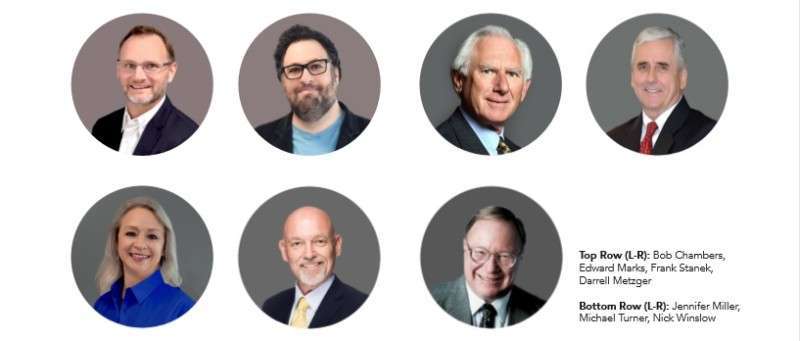
Future focus and brain trust
“I like to remind our designers and clients that there is the right approach and mix of technology for their attraction, and our job is to discover it, without any bias to the new or the old. If it’s right, then do it,” said Marks.
“The brain trust is one of the ways TPG stays on track to pinpoint and deliver what our clients and their audiences need from a project, and to maintain best practices,” said Chambers. “As advisors to TPG, these gifted and valuable colleagues help us focus on the future while learning from the past.”
The TPG advisors include 2013 Buzz Price Thea Award honoree and former Disney executive Frank Stanek, 2008-09 IAAPA chair Darrell Metzger (also a former Disney executive), and operations/feasibility/master planning maestro Nick Winslow, whose past professional leadership roles include Harrison Price Company, Warner Bros. Recreation Enterprises and the USA Pavilion at the 2010 Shanghai Expo.
The advisors meet regularly with TPG to talk about future ventures and how to make those ventures successful, bringing experience, perspective and mutual respect to the table. “The team at TPG is highly professional and very thorough, regardless of the size and difficulty of the project,” said Nick Winslow.
Everything old is new again
Winslow thinks the explosion of new and ever improving technologies such as digital projection and interactive gaming that support ever more immersive environments and deeper levels of guest engagement are positive signs of the future. “We’ll see more mixed media and interactive shows,” he said. “We’ll see more ride vehicles that incorporate some really neat technological elements and that will be combined with rides and attractions; we’re just at the tip of that.”
As technology continues to evolve, it is becoming more accessible. These advancements are becoming more budgetarily feasible, placing them within the reach of more operators and developers. In turn, those operators and developers are empowering designers to use that new technology to immerse visitors in ways never before imagined, fueling creativity and the emergence of new destinations.
But certain essentials don’t change. Chambers points out that while these new rides may be heavily focused on new technologies, they were built on industry foundations laid long ago. “There are original storytelling techniques and approaches from the Haunted Mansion at Disneyland, for instance, that we still reference for new attractions. Haunted Mansion remains a standard and a classic of dark rides in its application of theatrical devices and use of technology such as Pepper’s Ghost,” said Chambers. “While borrowing from theater to create an environment, when it comes to storytelling these rides borrow from cinema, enveloping and immersing guests in the story and the world of the story, controlling what you can and can’t see. You see the special effect, but not the mechanism that makes it work.”
“People don’t care about the technology per se – they care about the experience. It has to be a fun experience,” Winslow reminds us.
IP and immersion
Nowadays, attractions are frequently based on characters and stories first seen on other media platforms. Intellectual property (IP) owners and license holders have recognized the value and embraced location based entertainment (LBE) platforms to extend story and brand. They often turn to companies such as TPG to help them understand and navigate attractions development. “The key with intellectual property is relevance to the market,” Chambers points out.
There are plenty of precedents to learn from in IP-based attractions. Michael Turner, TPG’s Vice President of Global Business Development, cites Universal Studios’ blockbuster attraction, The Adventures of Spider-Man. “It was one of the first to fully integrate multimedia, physical sets, onboard audio and dynamic ride motion,” said Turner. “It set the stage nearly 20 years ago for what we are seeing now in The Wizarding World of Harry Potter, Shanghai Disneyland’s Pirates of the Caribbean and other fully immersive ride attractions.” As Disney gears up to leverage the Star Wars IP in new lands within its Anaheim and Orlando parks this year, the world is sure to see another leap forward. Immersion in these highly themed and/or branded spaces includes making visitors more active participants, and extending the theming to integrate more elements of the guest experience, such as retail/food and beverage.
Ultimately, in the LBE space, the IP brings value and receives value through delivering experience, immersion, and a deep level of guest engagement. “The emotional connection that people form with an intellectual property is one of the primary driving forces,” said Jennifer Miller of TPG. Miller was recently promoted to Vice President of Content Development and brings 25 years of industry experience to the table with production and project management credits on projects all over the globe. “At the end of the day, using the beloved IP of Harry Potter or Star Wars or Jurassic World gives visitors the chance to immerse themselves physically in something that previously had only been words on a page, static images or even audiovisual media. And that’s compelling.”
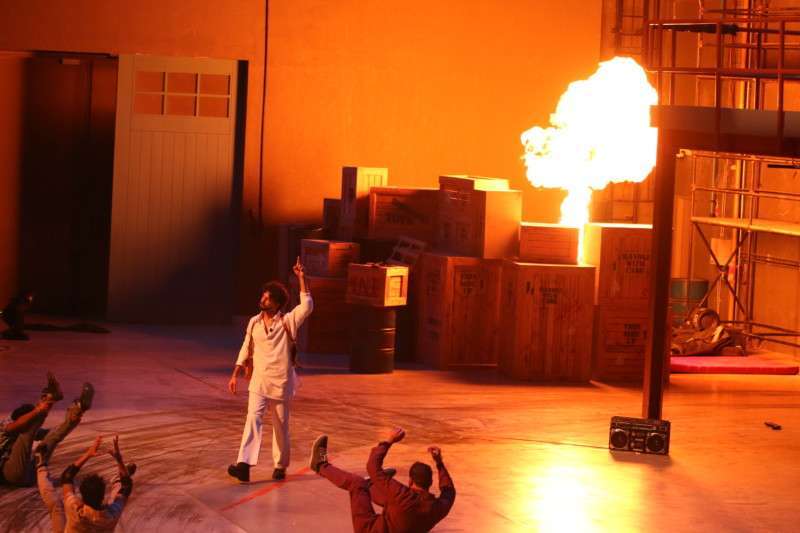
Going Live
While immersion and interactivity form a significant trend for theme parks and attractions, live shows also continue to reign. “Live experiences create a welcome balance to the digital and online experiences that so many are involved in,” Miller said. The trend is toward larger, more spectacular and more immersive shows, using an array of elements, media and effects to envelop audiences. These shows serve multiple needs: they can entertain large numbers of people, provide an engaging sit-down break, reach a wide demographic and reinforce the messaging of the park or venue.
“We will see more large-scale spectaculars as high park attendance continues to put a strain on attraction capacities,” said Marks.
One leading example is Crane Dance, a monumental, nighttime spectacle, celebrated since opening at Resorts World Sentosa in Singapore in 2010. Chambers and Marks, working with designer Jeremy Railton of Entertainment Design Corp., helped put together the groundbreaking show (and love story) with its two 30-meter tall cranes, water jets, lights and music. This project, which helped motivate Chambers and Marks to found TPG, went on to be honored with a Themed Entertainment Association (TEA) Thea Award in 2011. “TPG often finds itself in oneoff, never-before-done project territory as we did with Crane Dance,” said Chambers. “The attractions industry is always being called on to top itself, to differentiate and roll out the next thing, and that’s where past experience and a knowledge of past accomplishments can be most helpful.”
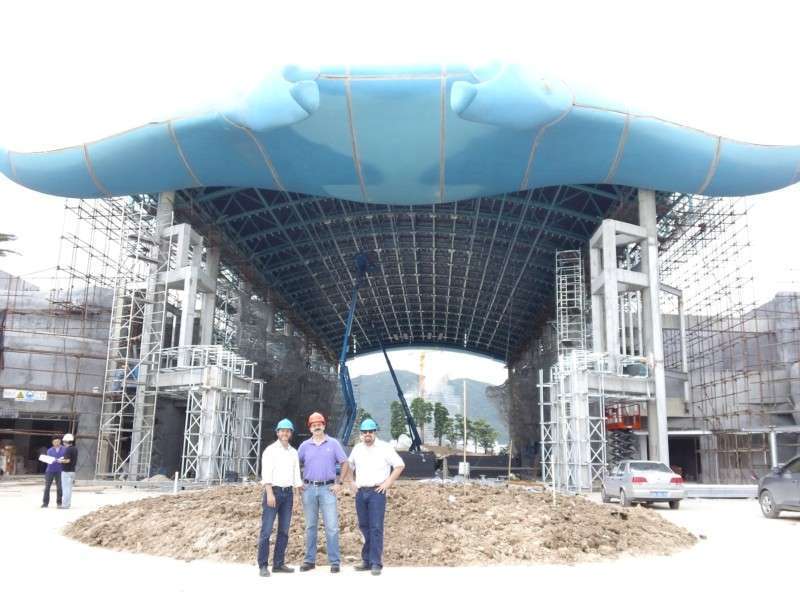
Theme parks everywhere
Around the world, the theme park is recognized as a viable business model to help stimulate development and destination tourism and provide more leisure and entertainment options to regional populations. Tokyo Disneyland, a pioneering example, was a project Frank Stanek helped develop while working as an executive at Disney. It opened in 1983. “We did 10 million in attendance the first year, and 17 million in the fifth year,” said Stanek. In contrast, he cited Hong Kong Disneyland, which opened in 2005, which took a number of years and reinvestment to become an established success. For its part, Shanghai Disneyland, which opened in 2016, has been considered a success from the start, with credit given to the collaborative approach taken by developers, joining the brand to regional sensibilities.
The sheer size of the latent market in China means there will be more parks. “China has over 300 million in the middle class,” said Turner. “The market is there to support these mega parks. The real question is whether that market is receptive and willing to support the higher end product these parks offer.”
Given the promise of the market, the many successful examples and the general upward trend in quality, there is no shortage of new and established players stepping up to embrace the risks and challenges in China. Universal is well underway with design and construction of its major new park in Beijing. Many other parks are in the Asian development pipeline. TPG’s list of Asian clients includes Evergrande, Haichang, Chimelong, Shanghai Disneyland, and the aforementioned Universal Beijing Resort.
Meanwhile, the United Arab Emirates (UAE) presents its own, unique development landscape and momentum in the quest to rapidly grow its tourist market. TPG’s work in this singular market sector has included the Dabangg: Stunt Spectacular Show that is part of Bollywood Parks™ Dubai [See “Family Friendly Bollywood,” InPark issue #62, May 2016]. The show features live stunt performers, along with careening vehicles, fire effects and more.
Attendance numbers for the new theme parks in Dubai are expected to take some time to reach initial projections, with a likely boost coming in tandem with Expo 2020 Dubai. “Dubai built its new parks and attractions to promote tourism, rather than for existing and near-term tourist market wants or needs,” said Chambers. “I have every expectation that the tourist numbers will rise with time to make those projects profitable.”
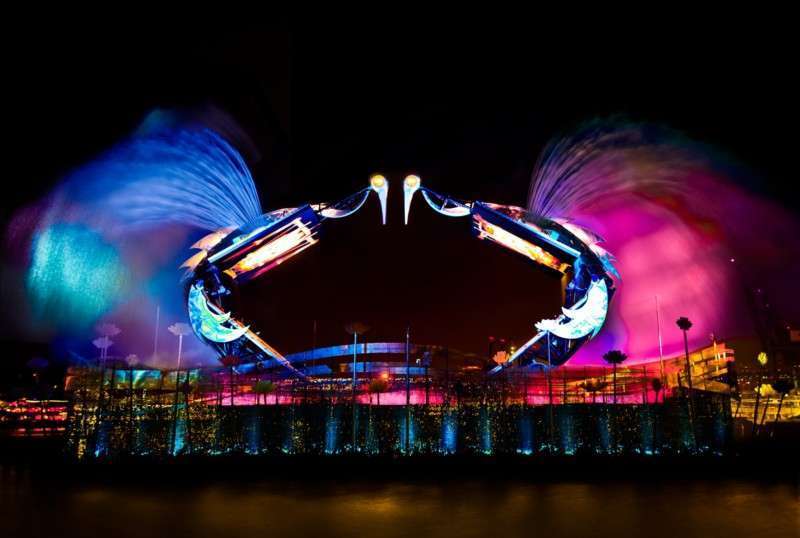
Crane Dance at Sentosa Island, Singapore. Photo courtesy Entertainment Design Corporation. 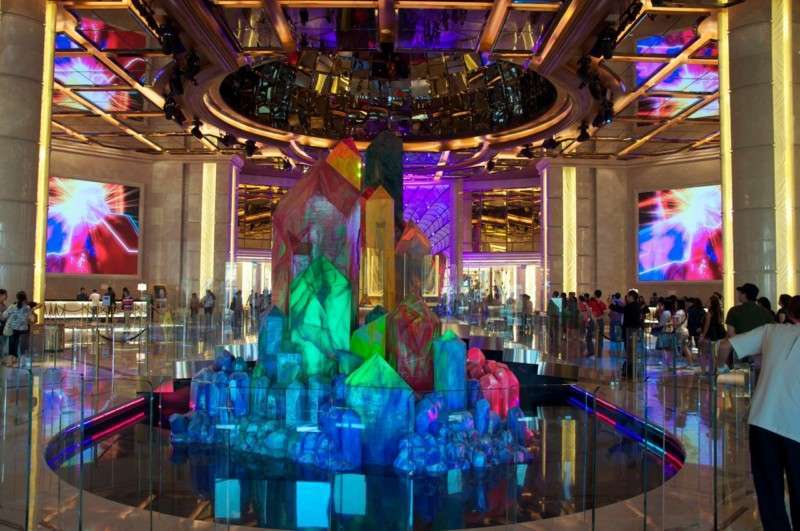
The Wishing Crystals at Galaxy Macau 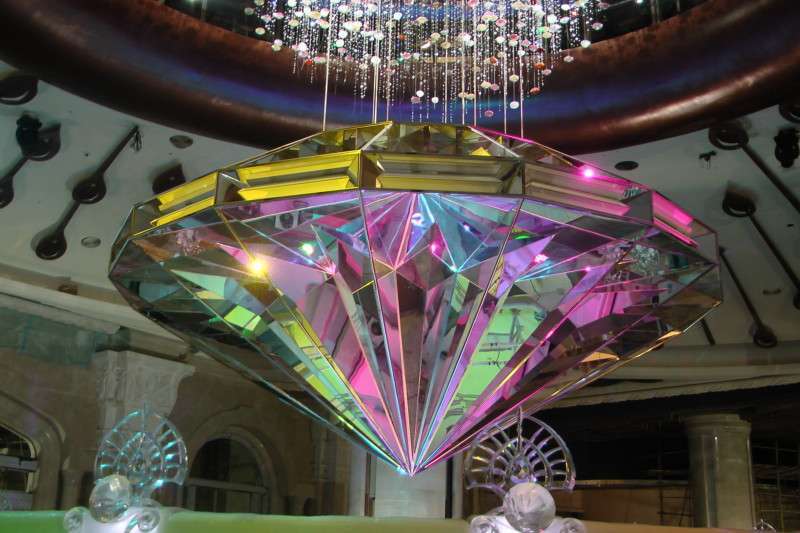
The Fortune Diamond Show at Galaxy Macau
Themed entertainment anywhere
As shopping centers and stores around the world struggle for re-definition in an era of shifting consumer behavior, themed entertainment is seen as one way to stem the “retailpocalypse.”
“Retail operators are attempting to create a unique, attractive, efficient destination… evolving to remain relevant and desirable, focusing on personalized connections with shoppers and technical innovations offering a seamless physical-to-online shopping experience,” said Miller. “As shopping malls bring more recreation and entertainment options to their locations, they are reinventing themselves as mixeduse destinations with increased levels of leisure and entertainment offerings.”
Filling those spaces with new ideas will not happen overnight, and not everything will work. “A big part of our design community is focused in those directions,” said Stanek. “The economics of all of this is going to take some experimentation to figure out which are the viable products to put in them.” Virtual Reality (VR) locations, for instance, have an inherent capacity issue that is a challenge to economic viability. Stanek suggests that shopping mall spaces might do well to explore short-term offerings. “We may see pop-up entertainment in these areas that have a life span of three to five years at the most.”
Adopting new business models of this kind will necessitate changing the culture of malls and mall ownership. “Imagine a mall that you feel a desire to visit every day or several times a week,” said Chambers. “It could include daily life needs such as child and adult care, dentist offices, along with dining and entertainment.”
On the dining front, TPG has a proprietary product of its own to offer, developed in partnership with Premier Rides, Inc. “Extraordinary Voyages® Adventure Dining®” is an immersive dining experience that will transport guests to fantastic destinations while they dine on delicious food and beverages. It will feature live actors and dramatic scenery outside the window of the “vehicle” they are riding in. [See “Napkin Sketch,” InPark issue #65, November 2016]
The next generation of parks, attractions, markets and visitors
Change is a given in the themed entertainment business, as operators continually reinvest to keep customers coming back, and new business models, markets and players emerge. It is how change is embraced that enables companies to move forward and stay in business. Walt Disney said his park would always change “as long as there is imagination left in the world.” The real question is the nature of that change and what form it takes.
“If it’s in a mature market, you have to do something that attracts the regional area more, or is big enough to bring tourists in,” said TPG advisory board member Darrell Metzger. That includes what he refers to as upselling: coming up with concepts to refresh and renew existing locations where attendance has leveled off, giving visitors a new reason to come out and spend money. He cited Singapore Zoo’s night safari where visitors can take a tour when the nocturnal animals are awake. “They made it into a dinner tour with a course at each stop.”
The costs of visiting a large theme park also augurs a change in spending patterns, for some. “People can’t spend all their money on big parks, so they’re going to Family Entertainment Centers,” said Metzger. “Shopping centers will fill up with those and become activity centers with some shopping, dining and entertainment.”
Changes in technology lead to changes in the way theme parks design their attractions.
“Technology is making it easier to create immersive experiences. The delivery method is changing every day with smart phones leading the way,” notes Turner.
That technology is well embraced by younger generations, and is visibly seen in everyday life. Parks and other entertainment centers are finding ways to adopt that technology, and will continue to do so going forward. “Technology will always be focused on the next generation, they’re the easiest to train to use it,” said Turner.
But technology is not just for the young. “We live in a world with an aging population and the percentages of the market 25 and younger are going down, while the percentages that are 55 and older are going up,” said Winslow. He thinks that the resurgence of dark rides and their emphasis on storytelling (as opposed to thrill rides) reflects this – they are designed to attract that population while also providing the interactivity and IP that appeal to the younger set.
To Asia, and beyond!
Where theme parks are built is also changing. The next several years will see more opportunities in the Asian market, and not just in China. “Developing countries offer huge opportunities,” said Stanek. He points to India’s huge population base and status as a relatively untapped market, as well as Russia and South America.
Themed entertainment companies that can adapt and build on these changes will survive and succeed in the future. It means embracing new tools that include total immersion, virtual reality, augmented reality, interactive opportunities, or simply new ways of getting people to go out to play, shop or eat.
“More themed entertainment options in the marketplace gives us and our designers more tools to work with,” said Chambers. “I’m excited for the future of our business, wherever it takes us.” • • •
Mark Eades ([email protected]) is a freelance writer residing in Southern California.






